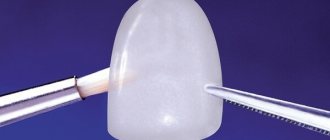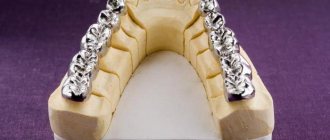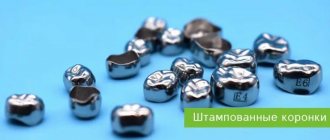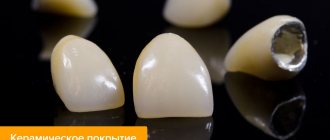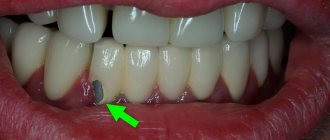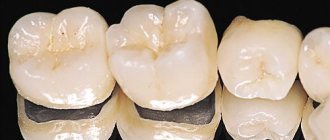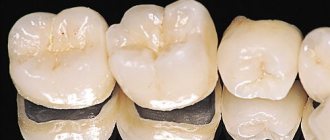Today, one of the most popular and popular methods of prosthetics is the installation of metal-ceramic crowns. The popularity of this material is explained by its natural appearance, close to natural teeth, increased strength and durability.
Due to the fact that metal ceramics are not prone to discoloration and abrasion, most patients believe that such products do not require special care. However, this is not the case.
The service life of metal-ceramic crowns depends on quality care. For cleaning use a toothbrush with soft bristles.
Movements are performed vertically from the gum to the edge of the tooth. The paste contains propolis and herbal infusions.
The surface is cleaned in the morning, evening and after each meal.
This type of construction also requires compliance and compliance with certain hygiene standards.
Content:
- Features of metal-ceramic crowns per tooth
- The need to install a metal-ceramic crown on a tooth
- The procedure for manufacturing metal-ceramic structures for teeth
- The procedure for installing a metal-ceramic crown on a tooth
- Rules for caring for metal-ceramic crowns
- Repair procedures for metal-ceramic crowns on teeth
A metal-ceramic tooth crown consists of two parts: metal and ceramic, respectively. Unhealthy teeth cause great discomfort and require the help of a specialist. When it is impossible to restore the original shape of teeth for a long time by filling, doctors suggest installing crowns. Metal-ceramic products are the best option for restoring teeth. The first layer is metal, it is responsible for the chewing function; ceramics are thinly applied to it. This coating does not cause allergic reactions, so it is suitable for most patients. The procedure is carried out by highly qualified specialists with experience. The quality of work on installing a crown on a metal-ceramic tooth is ensured by modern equipment and original materials.
Features of metal-ceramic tooth crowns
Such products can serve uninterruptedly for more than ten years; with the correct load during chewing, high-quality installation, and proper care, the period increases.
The manufacture of prostheses requires professional knowledge, materials whose quality is confirmed by a certificate, and laboratory conditions. By observing all the required standards, prosthetics will be completely safe for the client.
Despite the fact that metal-ceramic crowns do not emit toxic substances during use, they can behave in different ways in the mouth, each case is individual. A frame made of nickel or chromium-nickel alloy can cause allergies if the structure is based on a base metal; it will oxidize over time when in contact with saliva.
The high strength of the crowns allows for greater loads when chewing. Due to their aesthetic appearance, the products are often installed to cover the front teeth, as well as premolars and molars.
The metal-ceramic crown is highly durable, does not wear off and is not subject to carious changes.
There are cases of puncture, to eliminate the problem there is no need to remove the product; specialists correct the prosthesis in the oral cavity.
One of the disadvantages is the high degree of grinding of the abutment tooth. Most often, the tooth is depulped and the root canals are filled. In this case, it is necessary to remove the nerve to avoid burns to the pulp.
Making a crown for a tooth from metal-ceramics
Can I use dental floss?
If you have any dentures in your mouth, you should either refuse floss completely or use it too carefully. The crowns are fixed in such a way that natural micro-gaps between them are preserved, which require cleansing. However, when flossing, you should not make vertical movements - only horizontal ones. That is, you need to insert the thread not from the cutting edge, gradually moving towards the gums, but place its tip directly into the gap - make several horizontal movements and remove it in a similar way.
Do not use the prosthesis if it has a chip or crack - try to see a doctor as soon as possible to restore the integrity of the crown/inlay or for a prompt replacement. Otherwise, there is a high risk of developing inflammatory processes under the prosthesis.
The need to install a crown on a metal-ceramic tooth
It is advisable to install a metal-ceramic crown to restore a tooth that cannot be restored with filling, for installation on an implant, and also when tooth enamel is highly abrasive. Such prostheses can serve as a replacement for previous metal or plastic ones.
Metal-ceramics restores the natural shape of teeth with high precision and is almost the same in shape and texture. After prosthetics, the patient does not feel discomfort, there are no defects in speech and chewing function. It is practiced to install metal-ceramic dentures on teeth and crowns in the complete absence of dentition. The introduction of crowns is advisable regardless of the type of tooth.
Due to the hygiene and material, the crown is resistant to the influence of pathological microflora, bacteria, and fungi.
In case of abnormalities in the development of the dentition, if inlays or veneers are contraindicated, a crown will be the best option.
During operation, the prosthesis does not change color and is not affected by natural pigments, food coloring, nicotine, caffeine, etc.
Contraindications include:
- allergic reactions to product materials;
- periodontal disease and severe periodontitis;
- malocclusion;
- bruxism;
- low set teeth;
- excessive tooth mobility.
To avoid unwanted reactions and consequences after installing a prosthesis, you must carefully read the contraindications.
Making a crown on a tooth, before and after photos
What is the service life of different types of crowns?
As you know, any structure has a certain service life. Unnecessarily long use can lead to dire consequences.
So: how often should crowns be replaced?
It is believed that the average service life of a crown is 5-7 years. At one time, scientists proved that it is after such a period of time that the cement on which the crown is fixed begins to undergo changes. But this does not mean that the crown must be changed every 5 or 7 years. During this period, a doctor should evaluate it to understand whether it can still serve or whether the crown needs to be replaced.
In addition to the duration of use, during a preventive examination, the doctor evaluates the following parameters: the quality of the marginal fit of the crown to the tooth, the condition of the gums and bone tissue next to the crown, X-ray data of the tooth, patient complaints, etc.
The procedure for making crown structures for teeth made of metal-ceramics
- Before proceeding with crown modeling, the client is prescribed a series of laboratory examinations. To install a prosthesis, the patient's oral cavity must be completely healthy. Found open cavities are filled and professional cleaning is prescribed.
- Based on the results of the preparatory period, you can begin selecting the product. Some are known for their durability, while others come with more than a year's warranty.
- The production of the prosthesis is carried out in laboratory conditions in stages.
- To obtain a high-quality impression, the doctor carries out a procedure for preparing the supporting part of the chewing element. After which you can make a two-layer print. Then, permanent fixations or bridges are installed in place of the prepared teeth. The dentist must determine the center of closure of the dental system.
- The one-piece metal crown frame is precisely adjusted to size, and the ceramic veneer is selected to match the color of the patient’s teeth.
Preliminary treatment
Dental treatment is an important point not only before prosthetics or implantation, but throughout life. Timely sanitation of the oral cavity preserves the health and integrity of the dental system, avoids possible complications, as well as the spread of infection throughout the body. Treatment of abutment teeth , hidden and obvious carious cavities, acute inflammatory processes in periodontal tissues or bones is mandatory before starting any prosthetics. This will allow not only to eliminate defects or diseases that have arisen in a timely manner, but also to extend the service life of the prosthesis. Also, some fixed structures require mandatory endodontic treatment.
The procedure for installing a crown on a metal-ceramic tooth
After the preparatory procedures, the tooth must be sharpened to the size of the crown. An orthopedic dentist takes an impression to form a model of the prosthesis. The actual production of the crown is performed by a dental technician in a dental laboratory.
Typically, a crown on a tooth takes time to produce. Before receiving a permanent prosthesis, the client must visit a specialist at least three times. The duration of the entire process is from seven to ten days, not taking into account the treatment time.
While the permanent crowns are being made, the client will have a temporary plastic crown installed. This is necessary to protect the implant or ground tooth from the influence of food and saliva.
After trying on the finished product, if the patient is comfortable with the prosthesis, it is attached to the implant using a special solution.
Making a crown for a tooth from metal-ceramics
Stages of prosthetics with veneers
Veneers are thin ceramic plates that are fixed to the front surface of previously prepared teeth and allow them to correct cosmetic defects, change shape, size and color.
Crowns and veneers The first stage, as with any prosthetics, is a survey, examination and
diagnosis of the oral cavity .
If necessary, X-ray and laboratory tests are performed. A very important stage is planning future structures, taking into account not only the condition of the teeth and oral cavity, but also the gender, age, and character of the patient. The shape of the face, the gingival margin and smile line, and the individual characteristics of the teeth are assessed. The size of the veneers is predicted and calculated. A photographic record is being taken. The doctor models the future restoration on a computer using a special program and demonstrates the result to the patient. At the next visit, the teeth are prepared, starting with cleaning their surfaces from plaque. The required shade of filling material is selected. Under anesthesia, the front surface of the teeth is prepared and the required amount of enamel is removed. The next step is taking impressions. Based on the dental impressions obtained, a plaster model is cast in the laboratory to obtain an exact copy of the patient’s teeth, on which the dental technician makes future veneers. After the doctor has prepared the teeth, temporary veneers . A dental technician, using computer systems, special scanners, sensors and ovens, produces structures strictly according to the specified parameters.
At the next visit, the doctor tries on the finished structures. If necessary, adjustments are made, deficiencies are eliminated, and the bite is checked. Veneers are fixed to the teeth using special cement.
Rules for caring for a metal-ceramic tooth crown
- Fixed dentures (crowns) do not require individual care; standard hygiene procedures are sufficient. It is mandatory to brush your teeth in the morning and evening, just before bed. It is advisable to use special rinses to clean the mouth.
- The toothbrush should be soft and not injure the gums. It is recommended to use dental floss to remove food debris and plaque.
- For preventive purposes, it is recommended to remove tartar once every six months and grind high points on the dentures in a clinical setting.
- At the first sign of pain, you should visit a doctor. The cause of pain may be the onset of a new pathology or poor-quality installation of a metal-ceramic prosthesis.
- Clients should be aware that when undergoing an MRI, if necessary, the prosthesis may appear as a defect in the image, so they should inform the doctor about the presence of a crown before the procedure.
What hygiene products are needed and can be used?
What hygiene products are needed and can be used?
| NAME | DESCRIPTION |
| Toothbrush | The bristles should be soft or medium hard. Too hard ones can damage the material and leave small scratches on it, in which plaque will accumulate. The use of an ultrasonic or mechanical brush is allowed, but it is very important to carefully select attachments - they should not have plastic elements (often used to better clean or whiten teeth). |
| Toothpaste | It is better to use prophylactic toothpaste WITHOUT abrasive substances - they can damage the materials. |
| Irrigator | It will allow you to remove food debris from the interdental spaces, especially if several crowns are installed in a row or dental bridges are present - in such a situation, a stream of water will remove food debris from under the structure. |
| Mouthwash | It should be selected in accordance with existing oral problems - for example, to combat gum inflammation, to strengthen enamel or to prevent plaque accumulation. That is, regardless of whether you have dentures or not. |
Repair procedures for a metal-ceramic tooth crown
A common problem that patients present with is the occurrence of chips on their dentures. The restoration procedure depends on the size of the defect and how deep it is. Common cases are as follows:
- small nicks are removed quickly. The dentist polishes the chipped edges, processes them, and this completes the procedure;
- a medium to large nick, if the metal frame is not affected, requires restoration of the ceramic layer. The specialist uses a gel composite to restore the ceramics, selected by color. Polishing and grinding are carried out;
- in cases where the metal layer is exposed, the application of a metal frame is required. Opaque is applied, after which the ceramic layer is restored;
- cracks in the metal frame of the crown require complete replacement.
Metal-ceramic crowns are considered the most popular type of prosthetics. If you visit the dentist once every six months and take proper care of your oral cavity, the life of the crowns will be long, without the occurrence of defects.
The price of such a metal-ceramic crown directly depends on many components: the cost of the metal alloy from which the frame is made, the cost of the ceramic layer, payment for the work of the dentist, dental technician, patient characteristics, and the cost of additional services. Therefore, the cost is calculated for each case individually.
Stages of dental prosthetics with complete edentia
The production of a complete removable denture begins with an examination of the patient’s oral cavity, diagnosis of the condition of the dental system, and selection of a suitable design. The first impression is taken with a standard impression tray. Depending on which design is chosen, the impression mass is selected. The impressions are sent to the laboratory, where a dental technician casts plaster models and makes a wax base with occlusal ridges and custom impression trays.
On the second visit, using these trays, the doctor takes functional impressions, and using rollers, determines and fixes the occlusion. All information is transmitted to the dental technician. He makes the future prosthesis from wax with acrylic (plastic) teeth .
On the third visit, the structure in the oral cavity is checked, occlusion, fit, and the appearance of the patient’s face are assessed. The doctor makes the necessary notes and corrections and transfers the future design to the laboratory. The dental technician finally models the wax structure, plaster it into a cuvette where the wax is replaced with plastic. Next, he grinds and polishes the finished prosthesis.
At the next visit, the prosthesis is handed over. Finished structures are fitted, fit, occlusion and aesthetics are checked. The doctor will tell the patient how to use and care for the new prosthesis. During the adaptation period, additional corrections are possible.
